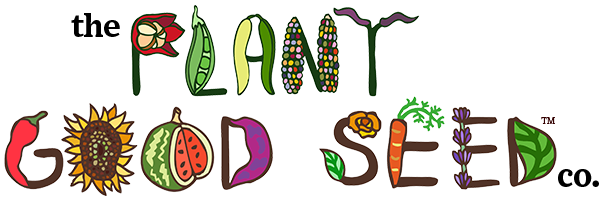Pomegranate Crunch Lettuce (Lactuca sativa) is a medium sized red romaine that is a market worthy producer. Fast growing with resistance to Downy Mildew and tomato Bushy Stunt Virus.
Bulk size only. Seeds are certified organic.
Here's a video of us saving this seed.
Pomegranate Crunch Lettuce (Lactuca sativa) is a medium sized red romaine that is a market worthy producer. Fast growing with resistance to Downy Mildew and tomato Bushy Stunt Virus.
Bulk size only. Seeds are certified organic.
Here's a video of us saving this seed.
Lettuce (Lactuca sativa) is one of the easier vegetables to grow, and nothing is quite like a salad of fresh-from-the-garden lettuce.
There are a few different types of lettuce that are all essentially grown the same way: butterhead; cos (romaine); loose-leaf; iceberg. Lettuce is considered a tender annual that grows seed to seed in one growing season. Some varieties may tolerate a light frost, but a hard freeze will certainly kill lettuce. It is fast growing, producing quite quickly in the right conditions. Lettuce prefers evenly moist, fertile soil and full sun in all but the hottest conditions. Partial shade is ideal if you're attempting to grow it in the heat of the summer in hot climes. Lettuce doesn't demand highly fertile soil, but if nutrients are available – especially nitrogen – lettuce will grow faster, be less prone to pest predation & disease, and some would say be more delicious.
Our favorite way to grow lettuce is to start the seeds indoors (or in a greenhouse) in multi-celled flats. Lettuce is probably the easiest vegetable to transplant, and shows little if any transplant shock. Sow 3-5 seeds per cell if you plan to thin out close-growing seedlings (as we do), or 2-3 seeds per cell if you desire a single plant per cell to plant out. Lettuce seeds are light-dependent germinators, so sow those seeds just barely under the surface of the soil, making sure to not let the soil surface dry out at all during germination.
When lettuce seedlings are 2-3 inches tall, transplant them into well-loosened garden soil that has been amended with finished compost or a broad-spectrum organic fertilizer. If you plan to be readily harvesting a lot of lettuce (as we do here), the starts can be tucked together pretty tight: 4-6" apart for romaine (tall head); 6-8" apart for the others (spreading habit). As the lettuce grows up, thin 1-2 plants from a cluster of 3-4 (all from a single cell, remember). This way of planting lettuce allows for an early harvest or two of not-quite-mature thinnings, and leaves a final plant or two in each space to grow to maturity now with more elbow room from the thinning! We're able to harvest a full bag of chopped lettuce for 25 CSA members every week for more than a month from 200 sq. ft! Brilliant!
If you plan on growing only a small handful of lettuce plants, it may be beneficial to give the starts a bit more space (8-10" apart) that will allow them to breathe a bit, and have more root-space, water and nutrients to grow healthfully to maturity and beyond. It's also a good idea to space the plants farther apart if you live in a humid/rainy climate – good air circulation is essential to avoiding disease in lettuce crops. Lettuce likes ample water, especially if it's growing in hot temps. If the soil is allowed to dry out, the lettuce leaves will become dry and lose their crispy texture and sweet flavor. On the flipside, you don't want to overwater lettuce either, which will influence rot and disease. Your watering interval will depend on many factors: sun exposure, soil type/texture, weather, etc. – you'll just have to experiment and observe.
Collections: All Products Bulk Sizes Lettuce
We use cookies on our website to give you the very best shopping experience we can. By using this site, you agree to its use of cookies.
Emails every 4-6 weeks featuring compelling original gardening content, new variety announcements, sales, and event appearances.
